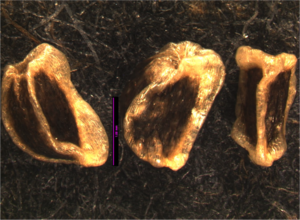Delphinium menziesii
Delphinium menziesii, commonly referred to as Menzies Larkspur. Synonyms/Subspecies
- Delphinium menziesii ssp. menziesii DC.
- Delphinium menziesii ssp. pallidum M.J. Warnock
Contents
Taxonomy
- Kingdom Plantae- Plants
- Subkingdom Tracheobionta – Vascular plants
- Superdivision Spermatophyta – Seed plants
- Division Magnoliophyta – Flowering plants
- Class Magnoliopsida – Dicotyledons
- Subclass Magnoliidae
- Order Ranunculales
- Family Ranunculaceae – Buttercup family
- Genus Delphinium- Larkspur family
- Species Delphinium menziesii- Menzies Larkspur
Description
Perennial from tuberous, clustered roots and usually less than 50 cm high. The stem is single and very slender usually with very fine hairs. The leaves are stalked and are mostly on the stems with the longest stalks on the few basal leaves and becoming shorter as they grow farther up the stem. The main leaf blades are two or three times palmately divided into narrowly oblong to wedge-shaped segments. Flowers are violet with the uppermost of the five petals being modified into a pronounced hollow spur. The petals are shallowly notched, ruffled, veined and wavy-edged. The upper two petals are often white. The lower flower-pedicals are usually much longer than the flowers. The flowers occur in 3-20 open, loose simple to branched terminal clusters. Blooms from May on the coast to June and July in the higher meadows
Bloom Period
Distribution
Hsbitat
Uses
Propagation
Photo Gallery
References
The Seed
Abbreviation – DEME
Seed sample from 2009
Features
Average measurement: 1.9 x 1.2 x 1
Measurement range: L: 1.5 – 2.3, W: 1.1 – 1.3, D: 0.9 x 1.2
Latitudinal cross section: obovate ![]()
Longitudinal cross section: elliptical ![]()
Seeds dark brown in a roomy, clear/white seed coat that bunches around hilum and seed edges. Bagginess of seed coat sometimes gives the seed a winged appearance.
Seed coat very finely longitudinal striate and glossy.
Basic Explanations and Assumptions:
The dimensions for the seeds are length x width x depth. The location of the hilum is used as the base of the seed, and the length is measured from hilum to the opposite apex. Where a style is present, the length is measured from the hilum to the bottom of the style. Width is measured at a right angle to the length at the widest part. Depth is measured at a right angle to the intersection of height and width lines.
Measurements included are the mean average for each measurement of ten separate seeds.
All measurements in millimeters unless otherwise noted.

